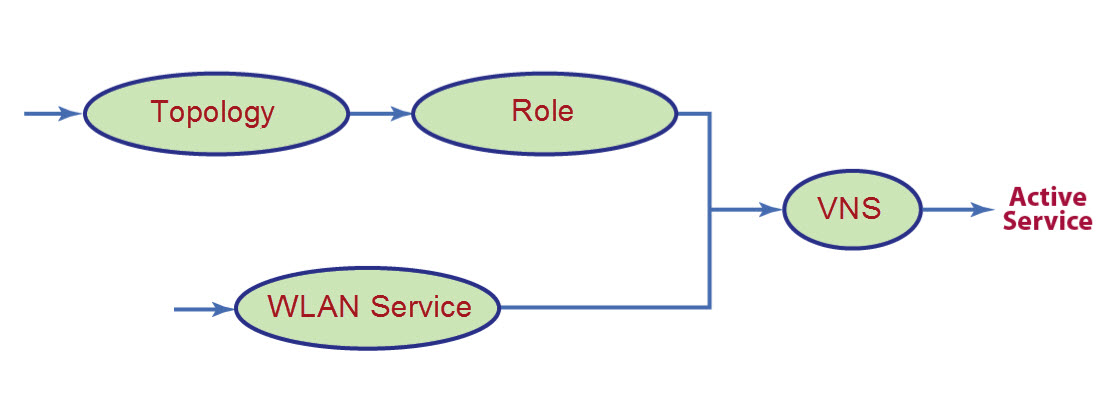Configuring a VNS
Setting up a VNS defines
a binding between a default role specified for wireless users and an associated
WLAN (Wireless Local Area Network) Service set, as shown in VNS Configuration Flow.
There are conceptually
hierarchical dependencies on the configuration elements of a VNS. However, the provisioning
framework is flexible enough that you may select an existing dependent element or create
one on the fly. Therefore, each element can be provisioned independently (WLAN services,
Topologies, and Roles). For service activation, all the pieces will need to be in place, or
defined during VNS configuration.
You can use the VNS
Creation Wizard to guide you through the necessary steps to create a virtual network
service (and the necessary subcomponents during the process). The end result is a fully
resolved set of elements and an active service.
The recommended order of
configuration events is:
- Before you begin,
draft out the type of services the system is expected to provide — wireless services,
encryption types, infrastructure mapping (VLAN (Virtual LAN)s), and
connectivity points (switch ports). Switch port VLAN configuration/trunks must match the
controller's.
- Set up basic
controller services such as NTP, Routing, DNS, and RADIUS Servers, using one of the
following methods:
- Run the
Basic Configuration
Wizard, or
- Manually
define the necessary infrastructure components such as RADIUS Servers. RADIUS
Servers are defined via the .
- Define Topologies.
Topologies represent the controller‘s points of network attachment. Therefore, VLANs and
port assignments need to be coordinated with the corresponding switch ports.
- Define Roles. Roles
are typically bound to Topologies. Role application assigns user traffic to the
corresponding network point of attachment.
- Roles define
mobile user access rights by filtering.
- Polices
reference the mobile user's traffic rate control profiles.
- Define the WLAN
Service.
- Define SSID
and privacy settings for the wireless link.
- Select the
set of APs and Radios on which the service is present.
- Configure the
method of credential authentication for wireless users (None, Internal CP, External CP, Guest Portal, 802.1x[EAP]).
- Create a VNS that binds the WLAN Service
to the Role that will be used for default
assignment upon user network attachment.
The VNS configuration page in turn
allows for in-place creation of any dependencies it may require. For example:
- Create a new
WLAN Service.
- Create a new
Role.
- Create
a new Topology.
- Create
a new Class of Service.


 Print
this page
Print
this page Email this topic
Email this topic Feedback
Feedback